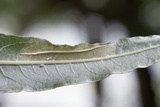Phyllonorycter pastorella (Zeller, 1846) Species
Last modified: Dec. 10, 2025, 5:45 p.m.
A fairly common species in Belgium, widespread in the northern parth of the country, but rare in the southern part.
Details
- Classification
- Family: Gracillariidae > Subfamily: Lithocolletinae > Genus: Phyllonorycter > Species: Phyllonorycter pastorella
- Vernacular names
- Late wilgenvouwmot (NL), Royal midget (EN), Später Weiden-Faltenminierer (DE)
- First mention in Belgium
- Fologne E. 1860. Lépidoptères et chenilles observés en Belgique. — Annales de la Société entomologique belge 4: 108–112. On page 111. view page
- Status
-
Native
Distribution
Imago
Head brown with a mixture of white hairs; forewing ground colour brown; whitish pattern consisting of some inconspicuous costal and dorsal striae. In some specimens, the forewing could be described as a white ground colour with brownish pattern. In both cases, there are two dark brown patches at the dorsal margin, just before and just after the centre.
Museum specimens
No pictures yet!Specimens in nature
No pictures yet!Caterpillar
Yellowish green when young, later instars have the thoracic segments and the first abdominal segment yellowish without any markings; abdominal segments 2–8 are somewhat darker yellow and with a distinct dark brown to blackish central patch in the middle of the dorsum. Sometimes the 9th abdominal segment also has such a patch. Head light brown.
Mine
A rather large, tentiform mine on the underside of a leaf, with one conspicuous, central, longitudinal fold. The mine occupies one side of the leaf, never crossing the main vein. On the upper side, the mine is visible as a light green patch, later on, when the caterpillar consumes the parenchyma, the mine becomes transparent whitish, with sometimes a remaining central green patch. The frass is concentrated in a corner of the mine.
See also gracillariidae.net and bladmineerders.be.
Bionomics
Pupation in the larval feeding place in a flimsy cocoon far from the corner where the frass is concentrated. Pupa dark brown. The species hibernates in the pupal stage. After the emergence of the adult, the pupal skin protrudes from the mine.
Flight periods
The adults fly in two generations a year in April–May and again in August–September.
Observed on
- Host plant (species):
- Salix alba and Salix babylonica
- Host plant (genera):
- Salix
The larva mines narrow-leaved willows with a preference for Salix alba and S. babylonica, much more rarely on S. fragilis. It also has been recorded occasionally on Populus.


